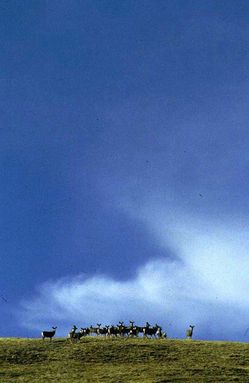Research Interests
Behaviour: Antipredator behaviour, cooperation, vocal communication, species interactions, animal welfare.
Ecology: Prey behaviour and predator-prey relationships, indirect effects among coexisting prey, hybridization, ungulates, canids, conservation
Ecology: Prey behaviour and predator-prey relationships, indirect effects among coexisting prey, hybridization, ungulates, canids, conservation
Cooperation and parental care in the context of predation
|
|
Whether a prey animal hides, flees or counterattacks when faced with an approaching predator influences myriad aspects of its behaviour, ecology and even psychology. Previously, I discovered large differences in cooperative behaviour between two deer species that are similar in size and closely related. Mule deer females engage in a highly aggressive and cooperative defence against coyotes. They defend fawns that are not their own offspring and will even defend fawns from another species, white-tailed deer. In contrast, white-tailed deer females only move toward the site of an attack if there is a possibility that their own offspring is the victim. My students and I showed that protection by mule deer females reduces the risk of capture for both mule deer and white-tailed deer fawns and that white-tailed deer females actively deposit their fawns within mule deer groups, apparently using mule deer females as baby-sitters.
Our research has led to breakthroughs in understanding how prey behaviour influences predator hunting success and, in turn, populations of prey and the predator-prey community. We used observations of coyotes hunting deer to show that differences in a prey’s tendency to flee or to fight influences the type of groups and habitats in which prey live. The different tactics prey use against predators even influence the time of year when fawns are most vulnerable to predators, thereby shaping the predator’s feeding habits and annual survival patterns for the prey population. Much of our work has been directed to understanding variation in cooperation and parental care, both from adaptive and mechanistic perspectives. Typically, it is the distress call, or cry, of a fawn that elicits a response by mothers. By using these cries in playback experiments with free-ranging deer, we ruled out traditional explanations for the mule deer’s defence of non-offspring such as misdirected parental care or kin selection. We found that mule deer and white-tailed deer mothers respond to conspecific distress calls as long as the pitch, or fundamental frequency (F0), fell within 50% of the mean F0 for newborn fawns. We then discovered that females respond to the cries of an extraordinary range of mammalian species, including seals, bats, marmots and human infants, as long as the F0 falls, or is manipulated to fall, within the deer’s species-specific range (see videos below). They did not respond to control sounds having the same F0. These results suggest that acoustic traits of a newborn’s cry that are essential for a response, and a caregiver's sensitivity to these acoustic features, are shared across diverse species of mammals. |
Current projects
We are grateful to many people who generously provided
recordings for use in acoustic analyses or playbacks: Dan Blumstein
(marmots), John Byers and students (pronghorn); Isabelle Charrier (fur
seals and sea lions), Jack Hogg (bighorn sheep), Ben Pitcher (seals),
Paul Faure (bats), Alan McElligott (fallow deer), Elodie Briefer
(goats), Radim Kotrba (cervids and bovids), Joah Madden (meerkats), and
Dan Mennill and the Mennill Sound Analysis Laboratory (bird distress
calls), Radim Kotrba (eland and other ungulates). We thank the
following people for making arrangements so that we could record their
study subjects or animals under their care: Jim Hare (ground
squirrels), John Byers and his students (pronghorn), and Chris Enright,
Charlene Berkvens, Robert Wrigley and other members of the animal care
staff at the Assiniboine Park Zoo.
2. Using behaviour to understand reproductive isolation and disease transmission in deer
3. Prey behaviour and predator-prey relationships
My students and I continue to use an exceptional field site and a long-term data set on the coyote, deer and ground squirrel populations to examine the influence of specific prey behaviours (e.g., cooperative defence versus individual flight) on coyote hunting success, fawn survival, the deer populations and and the larger predator-prey community. This work is based on the prairie grasslands of western Canada where we have the unique opportunity to observe coyotes as they hunt deer and other prey species.





